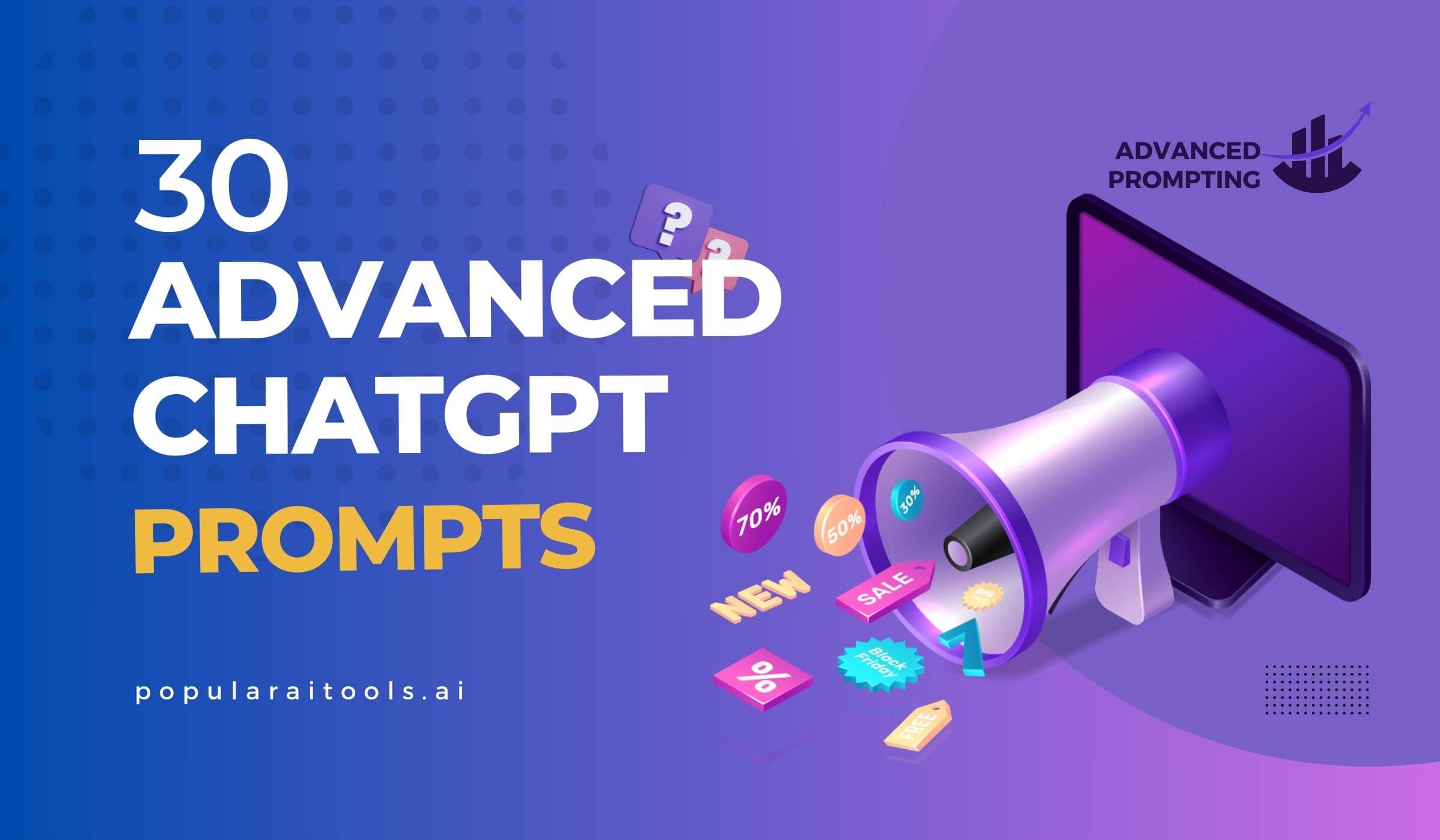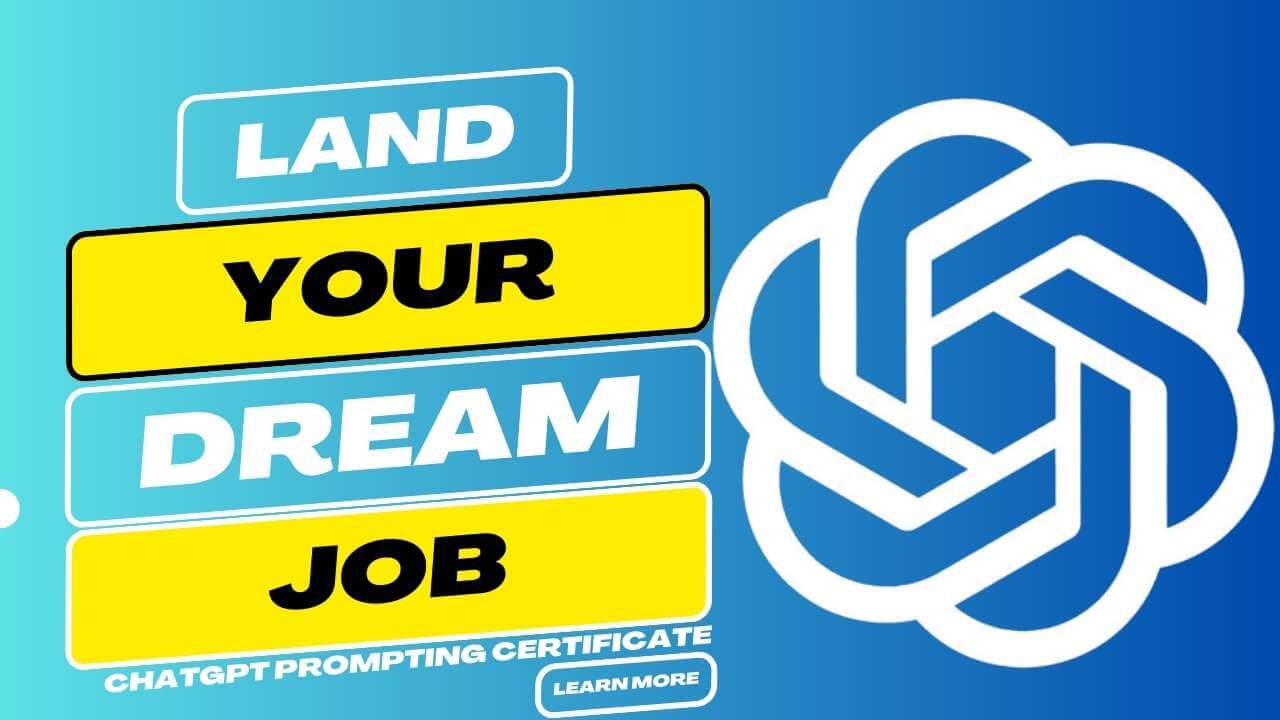
Are you looking to maximize your ChatGPT potential and stand out among the rest? Look no further, these 30 ChatGPT prompts will help you do just that!
ChatGPT, OpenAI’s language model, has become a popular tool for its versatility and ability to assist in a wide range of tasks. From writing creative social media captions to handling emails, ChatGPT has proven to be an invaluable asset. However, with so many potential uses, it can be overwhelming to know where to start. That’s why we’ve compiled a list of the 30 best ChatGPT prompts to help you get the most out of this powerful tool.
These prompts cover a wide range of topics, from personal use to professional use. Whether you’re a language teacher looking to effectively use AI to help students practice, or a public relations expert searching for AI-driven strategies to improve brand reputation, these prompts have something for everyone. Additionally, they provide a starting point for those who may not have a clear idea of how they would like to utilize ChatGPT.
By following these prompts, you’ll be able to utilize ChatGPT in new and innovative ways, allowing you to complete tasks more efficiently and effectively. So whether you’re an experienced ChatGPT user or just starting out, these prompts will help you get the most out of this powerful tool. Get ready to take your ChatGPT experience to the next level!


Learn how to use ChatGPT Prompts properly:
- Discover my writing style and handle emails: Get ChatGPT to understand your writing style and assist in managing your email responses effectively.
- High temperature setting for creative responses: Unleash ChatGPT’s creative side with a high temperature setting and receive innovative responses to questions.
- Low temperature setting for conservative responses: Play it safe with a low temperature setting and receive conservative answers to questions.
- ChatGPT as a cybersecurity expert: Get expert advice from ChatGPT on how to protect sensitive information from potential AI threats.
- ChatGPT as a nutritionist: Receive healthy meal options from ChatGPT to maintain a balanced diet for busy lifestyles.
- ChatGPT as a language teacher: Utilize ChatGPT as a language teacher to help students practice and improve their conversational skills.
- ChatGPT as a career advisor: Get the most out of AI tools to create compelling resumes and cover letters with the help of ChatGPT.
- ChatGPT as a public relations expert: Receive AI-driven strategies to improve brand reputation and increase media coverage from ChatGPT.
- ChatGPT as a data scientist: Use ChatGPT’s knowledge as a data scientist to analyze and predict consumer trends with AI and machine learning.
- ChatGPT as a travel agent: Get personalized travel recommendations from ChatGPT based on clients’ preferences and budget.
- Generate a comparison table: Create a comparison table of the top AI writing tools with the help of ChatGPT.
- ChatGPT for brainstorming ideas: Generate creative marketing campaign ideas with the help of ChatGPT.
30 Advanced ChatGPT Prompts that will catapult you to the top 1% of ChatGPT Users
Discover my writing style and handle emails
“What is an effective prompt to train ChatGPT on my writing style and allow it to manage my email responses?”
High temperature setting for creative responses
“Provide a creative response to the following question with a temperature setting of 1.0: What are the most innovative uses of AI in marketing?”
Low temperature setting for conservative responses
“Give a conservative response to the following question with a temperature setting of 0.1: How has AI impacted customer service?”
ChatGPT as a cybersecurity expert
“As a cybersecurity expert, how would you recommend businesses protect their sensitive information from potential AI threats?”
ChatGPT as a nutritionist
“As a professional nutritionist, what are some healthy meal options for people with busy lifestyles to maintain a balanced diet?”


ChatGPT as a language teacher
“As a language teacher, how can I effectively use AI to help my students practice and improve their conversational skills?”
ChatGPT as a career advisor
“As a career advisor, how can I utilize AI tools to help job seekers create compelling resumes and cover letters?”
ChatGPT as a public relations expert
“As a public relations expert, what are some AI-driven strategies to improve brand reputation and increase media coverage?”
ChatGPT as a data scientist
“As a data scientist, how can I use AI and machine learning to analyze and predict consumer trends?”
ChatGPT as a travel agent
“As a travel agent, how can I use AI technology to provide personalized travel recommendations for clients based on their preferences and budget?”
Generate a comparison table
“Create a comparison table of the top AI writing tools. Include columns for Name, Features, and Pricing. Summarize the following tools: [tools]”
ChatGPT for brainstorming ideas
“Generate a list of 10 creative marketing campaign ideas that leverage AI technology to engage customers and drive sales.”
ChatGPT for book summaries
“Write a concise summary of the book ‘AI Superpowers’ by Kai-Fu Lee in three paragraphs.”
ChatGPT for educational content
“Create a short lesson on the history of AI and its key milestones, suitable for high school students.”
ChatGPT for customer service scripts
“Write a customer service script for an AI-powered chatbot that helps users troubleshoot common issues with a software product.”

ChatGPT for social media captions
“Generate 5 catchy Instagram captions for a series of posts showcasing the benefits of AI in daily life.”
ChatGPT for product descriptions
“Write a compelling product description for an AI-powered language learning app that uses gamification to keep users engaged.”
ChatGPT for event promotion
“Craft an email invitation for an AI and Machine Learning conference that highlights key speakers, topics, and benefits of attending.”
ChatGPT for podcast scripts
“Write an introduction for a podcast episode discussing the ethical considerations of AI technology and its impact on society.”
ChatGPT for blog post outlines
“Create an outline for a blog post exploring the future of AI in the healthcare industry and its potential benefits and challenges.”
Transform a paragraph into bullet points
“Convert this paragraph into a concise set of bullet points highlighting the main ideas: [paragraph]”
Transform a paragraph into a 280-character summary
“Condense this paragraph into a 280-character summary suitable for a tweet: [paragraph]”
Transform a paragraph into a table
“Reformat this paragraph into a table with appropriate headings and rows to display the information clearly: [paragraph]”
ChatGPT for interview questions
“Generate a list of 7 thoughtful interview questions to ask an AI researcher about the future of artificial intelligence.”
ChatGPT for content repurposing
“Take this blog post and suggest 5 ways to repurpose its content for various platforms and formats: [blog post link]”
ChatGPT for SWOT analysis
“Conduct a SWOT analysis of an AI startup focused on developing autonomous vehicles.”
ChatGPT for video scriptwriting
“Write a 60-second video script introducing a new AI-powered fitness app and highlighting its unique features.”
ChatGPT for market research surveys
“Design a short survey to gather consumer opinions on AI integration in smart home devices.”
ChatGPT for company mission statements
“Craft a powerful mission statement for an AI-driven company focused on improving mental health and well-being.”
ChatGPT for brainstorming event names
“Generate a list of 5 catchy names for an annual AI and technology conference aimed at industry leaders and innovators.”
These 30 ChatGPT prompts are just the tip of the iceberg when it comes to the possibilities of this powerful tool. Whether you’re a language teacher, data scientist, or just looking for assistance in your day-to-day tasks, ChatGPT has the ability to help. So don’t wait, start exploring these prompts today and discover the full potential of ChatGPT!
FAQ’s
What are the best ChatGPT prompts?
The best ChatGPT prompts are those that are clear, concise, and specific. They enable the AI model to generate relevant and accurate responses, making them more useful for users. Some examples of effective prompts include:
- Generate a 500-word blog post about the top 10 productivity tools for 2023.
- Describe the process of creating an engaging social media marketing campaign.
- Write a step-by-step guide for using ChatGPT Keyword Prompt for keyword research.
For more examples of engaging ChatGPT prompts, check out this blog post on 7 Engaging ChatGPT Prompts.
What is a prompt in ChatGPT?
A prompt in ChatGPT refers to the input text that users provide to the AI model, which then generates a relevant response based on the input. Prompts can vary in length and complexity, from simple questions to detailed instructions for content creation. In essence, a prompt acts as a starting point for the AI to create output tailored to the user’s needs.
To learn more about prompting, read our blog post on Mastering Prompt Engineering: 10 Inspired ChatGPT Prompts.
How do you write ChatGPT prompts?
Writing effective ChatGPT prompts involves clear communication, specificity, and an understanding of the AI’s capabilities. Here are some tips for writing ChatGPT prompts:
- Be clear and concise: Use simple language and avoid ambiguity.
- Be specific: Provide enough context and detail for the AI to understand your requirements.
- Set the desired format: If you have a preferred format or structure for the output, mention it in the prompt.
- Limit the response length: If necessary, specify the desired word count or character limit.
For more information on writing ChatGPT prompts, explore our blog post on Mastering ChatGPT Prompting to Boost SEO.
What is the best way to use ChatGPT?
The best way to use ChatGPT is to leverage its powerful language generation capabilities to improve various aspects of your work or personal projects. Some popular use cases include:
- Content creation: Generate blog posts, social media content, or marketing copy.
- Brainstorming: Generate ideas, story prompts, or product names.
- Research: Summarize articles, answer questions, or provide explanations.
- Editing: Refine and improve existing content by rephrasing or expanding.
For an in-depth guide on using ChatGPT for various tasks, check out 10 Must-Try AI Tools to Boost Your Productivity in 2023.
What is 500 writing prompts?
500 writing prompts refer to a collection of creative writing prompts designed to inspire and encourage writing, often used by writers, students, and educators. These prompts can range from simple one-liners to complex scenarios, designed to spark imagination and encourage the development of writing skills.
What are 5 minute writing prompts for adults?
5-minute writing prompts for adults are short and engaging writing prompts intended to be completed within a short time frame, usually around five minutes. These prompts are designed to help busy adults practice their writing skills, enhance creativity, and encourage self-expression without requiring a significant time commitment.
What is the most intrusive prompt?
The most intrusive prompt refers to a question or request that invades someone’s privacy or delves into personal or sensitive information. In the context of ChatGPT, it’s crucial to avoid using intrusive prompts that may generate inappropriate or harmful content. It’s essential to respect users’ privacy and adhere to ethical guidelines when using AI-powered tools.
What is least to most prompts?
Least to most prompts is a concept related to the “least-to-most prompting” strategy, which is often used in teaching or training. This approach involves starting with the least intrusive or supportive prompt and gradually increasing the level of assistance as needed. The goal is to encourage independent problem-solving and skill development by only providing support when necessary.
What are some good story prompts?
Good story prompts are those that inspire creativity and provide a starting point for developing unique and engaging narratives. Some examples of compelling story prompts include:
- A mysterious letter arrives in the mail, revealing a long-lost family secret.
- A time traveler accidentally alters a historical event, causing unexpected consequences.
- A group of strangers becomes stranded on a deserted island and must work together to survive.
For more ideas on story prompts, consider using a Midjourney Prompt Generator to spark your imagination.
What are smart prompts?
Smart prompts are well-crafted questions or statements designed to generate high-quality responses from AI language models like ChatGPT. These prompts are usually clear, concise, and specific, enabling the AI to generate relevant, accurate, and engaging content. Smart prompts often include context and desired output format, helping the AI understand the user’s requirements better.
What does GPT stand for?
GPT stands for “Generative Pre-trained Transformer.” It is a type of AI model developed by OpenAI, which uses deep learning techniques to understand and generate human-like text. GPT is a transformer-based model, meaning it utilizes self-attention mechanisms to process and generate text efficiently and effectively.
What is the least intrusive prompt?
The least intrusive prompt is a question or request that respects the user’s privacy and avoids sensitive topics. In the context of ChatGPT, it’s essential to use non-intrusive prompts that adhere to ethical guidelines and encourage the generation of appropriate and helpful content.
What are one-word prompts?
One-word prompts are single-word stimuli used to inspire creativity, encourage writing, or generate ideas. These prompts are typically open-ended and can lead to various interpretations, making them useful for brainstorming, creative writing, or art projects.
Who invented ChatGPT?
ChatGPT was developed by OpenAI, an AI research lab founded by Elon Musk, Sam Altman, Greg Brockman, Ilya Sutskever, John Schulman, and Wojcieciech Zaremba. OpenAI is dedicated to advancing artificial intelligence and creating models like GPT-3, the underlying technology behind ChatGPT, to provide users with powerful language generation capabilities.
What are provocative prompts?
Provocative prompts are questions or statements designed to stimulate thought, challenge assumptions, or incite strong emotional reactions. These prompts can be used to spark engaging discussions, inspire creativity, or encourage self-reflection. However, it’s important to use provocative prompts responsibly and consider the potential impact on the audience.
What are least prompts?
Least prompts refer to the minimal amount of assistance or guidance provided in a teaching or training context. The goal of using least prompts is to encourage independent problem-solving and skill development by offering support only when necessary. In the context of AI language models like ChatGPT, least prompts can be simple, open-ended questions or statements that allow the AI to generate a wide range of responses.
What are natural prompts?
Natural prompts are questions or statements that arise organically in a conversation or discussion. These prompts often feel intuitive and unforced, allowing for a more fluid and engaging interaction. In the context of ChatGPT, natural prompts help the AI generate responses that feel more human-like and relevant to the user’s needs.
What are provocation words?
Provocation words are terms or phrases that can evoke strong emotions, challenge assumptions, or incite reactions from the audience. These words can be used intentionally to spark debate, inspire creativity, or encourage critical thinking. However, it’s important to use provocation words responsibly and consider the potential impact on the audience.
What are examples of provocative?
Examples of provocative content can include controversial statements, thought-provoking questions, or emotionally charged images. Some examples might be:
- A controversial opinion piece that challenges popular beliefs.
- Artwork that explores sensitive social or political issues.
- A debate topic that encourages participants to question their assumptions.
It’s important to remember that using provocative content should be done responsibly and with consideration for the potential impact on the audience.
Is it good to be provocative?
Being provocative can have both positive and negative effects, depending on the context and intention. When used responsibly, provocative content can encourage critical thinking, stimulate creativity, and foster engaging discussions. However, being provocative can also incite strong emotional reactions and potentially cause offense or harm. It’s essential to use provocative content carefully and consider the potential consequences on the audience.
What are provocative behaviors?
Provocative behaviors are actions or statements that are intended to elicit strong emotional reactions, challenge assumptions, or incite conflict. These behaviors can be used to draw attention, spark debate, or inspire change but can also lead to negative consequences if not used responsibly. It’s important to consider the potential impact of provocative behaviors on others and act with care and empathy.
What are provocative movements?
Provocative movements are actions or gestures that can evoke strong emotions or challenge social norms. These movements can be used intentionally to draw attention, inspire creativity, or encourage critical thinking but can also provoke negative reactions if not used responsibly. It’s important to use provocative movements thoughtfully and with consideration for the potential impact on the audience.
What does provocative text mean?
Provocative text refers to written content that is designed to elicit strong emotional reactions, challenge assumptions, or incite debate. This type of content can be used to engage readers, stimulate creativity, or encourage critical thinking but must be used responsibly and with consideration for the potential impact on the audience.
What are provocations for school?
Provocations for school are thought-provoking questions, statements, or activities that are designed to engage students, stimulate critical thinking, and foster curiosity. These provocations can take various forms, such as open-ended questions, challenging statements, or hands-on activities that encourage exploration and inquiry. Teachers can use provocations to spark discussions, inspire creativity, or deepen understanding of complex topics. To learn more about incorporating provocations in the classroom, explore AI-Powered Content Creation Tools that can assist educators in developing engaging lesson plans and activities.
Is provocative causing annoyance?
Provocative content or actions can sometimes cause annoyance or negative reactions, depending on the context and intention. While provocative content can inspire critical thinking and creativity, it can also provoke strong emotional responses or conflict. It’s essential to use provocative content thoughtfully and with consideration for the potential impact on the audience.
How do you write a provocation?
To write an effective provocation, follow these steps:
- Identify your goal: Determine the purpose of your provocation, whether it’s to spark discussion, challenge assumptions, or inspire creativity.
- Choose a topic: Select a subject that is relevant to your audience and has the potential to evoke strong emotions or reactions.
- Craft a clear and concise statement or question: Use simple language and focus on the core issue to provoke thought and discussion.
- Consider the potential impact: Be aware of the potential consequences of your provocation and ensure it aligns with your intended goal.
For more information on writing thought-provoking content, check out Best ChatGPT Prompts for Twitter Threads to learn how AI-generated prompts can inspire engaging discussions on social media platforms.
What are 5 minute writing prompts for adults?
5-minute writing prompts for adults are short, engaging prompts designed to inspire quick bursts of creativity and encourage daily writing habits. These prompts can range from thought-provoking questions to creative story starters, suitable for various writing styles and preferences. For AI-generated writing prompts and content creation assistance, check out 10 Must-Try AI Tools to Boost Your Productivity in 2023, which features a curated list of AI tools that can help streamline your writing process.
What are examples of natural prompts?
Natural prompts are questions or statements that arise organically in a conversation or discussion. Examples of natural prompts might include:
- “Tell me more about your recent trip.”
- “How do you feel about the latest news on climate change?”
- “What inspired you to start your own business?”
To learn more about crafting engaging prompts for various purposes, explore Master Prompt Engineering: 10 Inspired ChatGPT Prompts, which provides insights into creating effective prompts for AI language models like ChatGPT.

